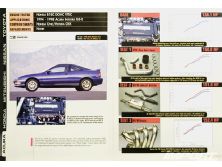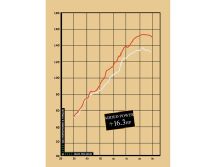When Import Tuner first emerged on the scene 10 years ago, its most looked-forward-to section quickly became Power Pages. Spawned by Turbo magazine, it came as no surprise that 2NR was very tech heavy from the get-go; everyone expected the usual how-to install articles and import-related product reviews, but when dyno-tested comparisons between aftermarket performance parts were published in the first issue, enthusiasts finally got a taste of the legitimacy their scene needed. No longer could manufacturers sucker buyers in with claims of outrageous power gains brought by adding their product. "Brand X" part, which was touted as the most powerful on the market, was finally being tested alongside "Brand Y". Even some OEMs were being called out on inflated factory power figures, while others, it was discovered, were making cars much more powerful than they were claiming.
Of course, this also meant that Johnny Civic Owner soon realized the intake, header and exhaust he added to his 1.6L D-series Civic really didn't free-up the additional 40 whp he'd thought... but now he had proof that the 1.8L DOHC swap, and bolt-on turbo kit he'd had his eye on would, in fact, make more than enough power to take out his muscle car-driving arch-rivals. But at the base of it all, Power Pages allowed the strongest engines and performance products to shine through the hype and mis-information fog, paving the way for the development of increasingly powerful vehicles and products that we all enjoy today. In this anniversary issue, we review 10 past Power Pages articles, highlighting ten of the most prolific engines to come out of Japan, and some of the most effective aftermarket parts created for them, that together, helped prove why import culture is here to stay.
Car: '98 Acura Integra GSR
Engine: B18C1
PeakHP: 152.4
For our first entry, we thought it logical to start at the beginning, with 2NR's very first issue and one of the import scene's most iconic engines: Honda's B18C1. The DC2 Integra GSR had existed in the states for four years prior to 2NR's first encounter with it, so many performance parts had already been developed for the car; meaning the 2NR staff had the luxury of selecting three time-honored upgrades that had improved power output of older B18C engines significantly. But it was also here that we see our first hardships with modifying newer engines: the '98 B18C's OBD 2 engine management didn't react as favorably to modification as previously tested OBD 1 engines had in the past. Where the addition of the RS-R header had made 10 whp in previous testing by the 2NR crew on an OBD1 GSR (in Turbo magazine), it made less than 1 whp on the current car, and a cat-back exhaust that could've easily made over 5 whp on the older car, now made under 2. Genuine tuning would be needed to recoup this loss of power - something reviewed in later issues - but with the only remaining part freeing up over 16 horses at the wheels, "AEM" and "cold air intake" soon became household terms across the country.
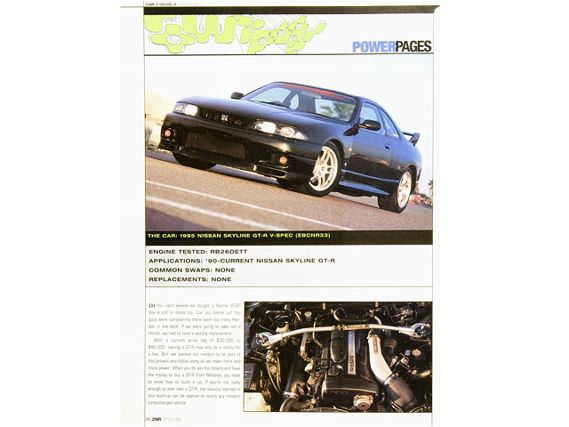 | Top 10 Power Pages
| Top 10 Power Pages
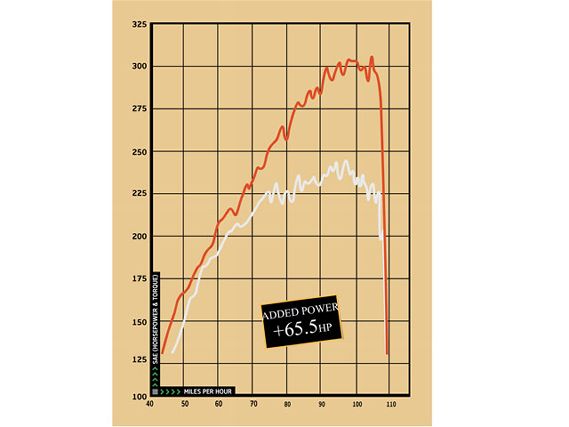 | Top 10 Power Pages
| Top 10 Power Pages
Car: '95 Nissan Skyline Gt-R V-Spec
Engine: RB26Dett
PeakHP: 309.6
Fast forward about two years and you'll see our test of another one of the import scene's most iconic engines, albeit at a completely different end of the spectrum: the RB26DETT. If having a modified B18C in your ride made you one of the cool kids, sporting an RB26DETT made you a god. It was our unicorn engine: not only would it's price, alone, put it out of reach for most of us, Nissan Japan never intended for the damned thing to make it onto our shores at all. Regardless, the 2NR crew scored an R33, and coaxed 50 whp out of its RB26 just by adding intake filters and an exhaust, and another 15.5 by increasing octane a few points, since GT-Rs are tuned by Nissan to run at least 95-octane gas-not crappy California 92 available during testing. It was some of the first published, Stateside evidence of just how much power the RB26 was capable of with little modification, and hinted of much bigger power gains to come.
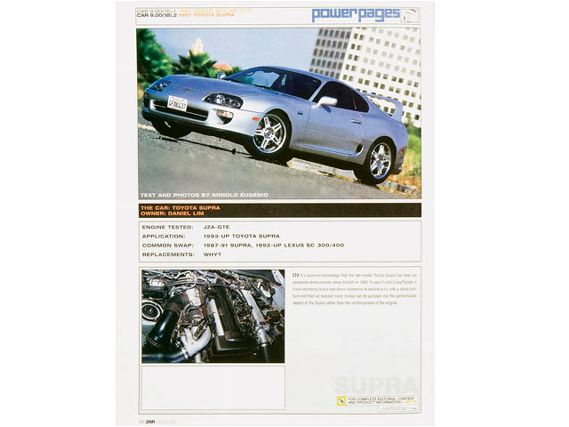 | Top 10 Power Pages
| Top 10 Power Pages
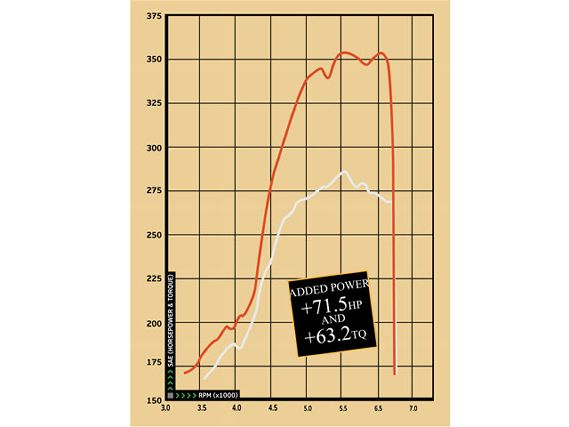 | Top 10 Power Pages
| Top 10 Power Pages
Car: '97 Toyota Supra Twin Turbo
Engine: 2JZ-GTE
PeakHP: 357.4
PeakTQ: 337.8
Later the same year, Japan's true heavyweight inline-six supercar first hit the 2NR dyno rollers in showroom-stock form, with the highest baseline power number thus far recorded in testing. After mere bolt-on enhancements, its 2JZ-GTE's power output was increased by 20% to just over the 350whp mark, with plenty more room to grow before the need to even touch a boost controller. The same year, Craig Paisley was drag racing stock-bottom end 2JZ-powered Supras deep into 8-second territory; making abundantly clear the power-holding potential offered by Toyota's premier 3.0L inline-six. Its legitimate Stateside release may keep the 2JZ from sharing the outlaw allure enjoyed by the RB26, but the twin-turbo Supra continues to roll atop the modern-day muscle car food-chain, and is one of the most sought-after platforms by any performance enthusiast to this day; try finding a decent one for under $20,000.
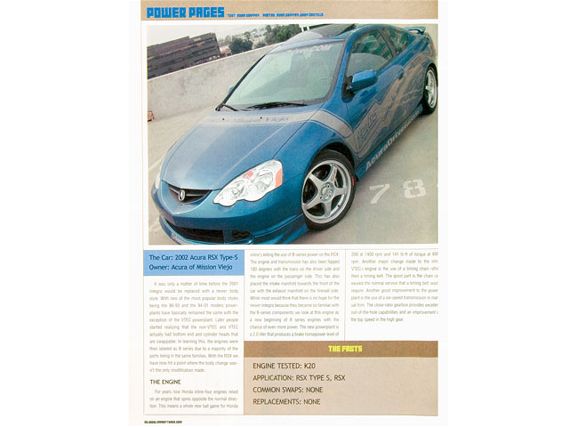 | Top 10 Power Pages
| Top 10 Power Pages
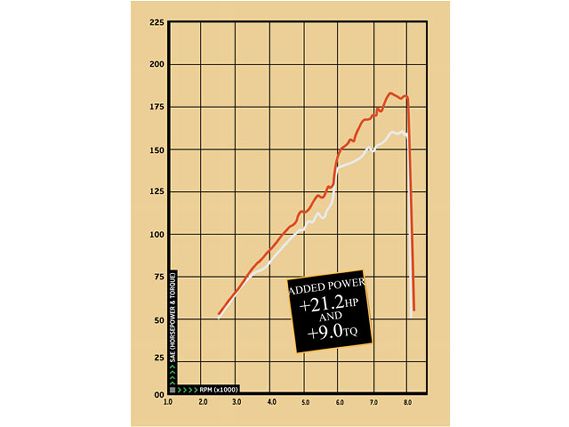 | Top 10 Power Pages
| Top 10 Power Pages
Car: '02 Acura RSX Type S
Engine: K20A2
PeakHP: 181.1
PeakTQ: 129.6
Honda and Acura platforms had become such a mainstay in the import scene during the '90s, that when the lackluster EM and ES Civics were released in '01, and the company announced plans to retire the Integra, Honda loyalists thought all was lost. The crowd-favorite B18C1, B18C5 and B16A engines were all officially killed and the company once responsible for creations like the Integra Type R and Civic Si had apparently traded performance for mainstream appeal. Later, when Honda announced details of the all-new RSX, and with it, the K-series engine, enthusiasts weren't quick to bite. But when 2NR tracked down an RSX Type S for Power Pages only months later, and made over 20 whp by bolting on a simple short-ram intake and cat-back exhaust-two of the only products available for it at that time-the once-scorned Honda community began to take notice. Fast forward to the modern day, and if you're looking to do a swap in a FWD Honda, chances are the engine you're lusting for begins with a "K".
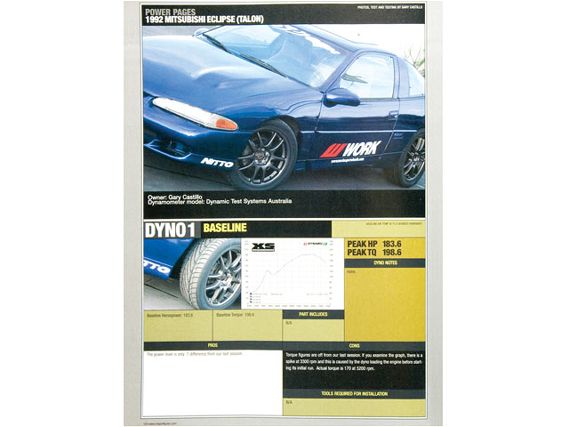 | Top 10 Power Pages
| Top 10 Power Pages
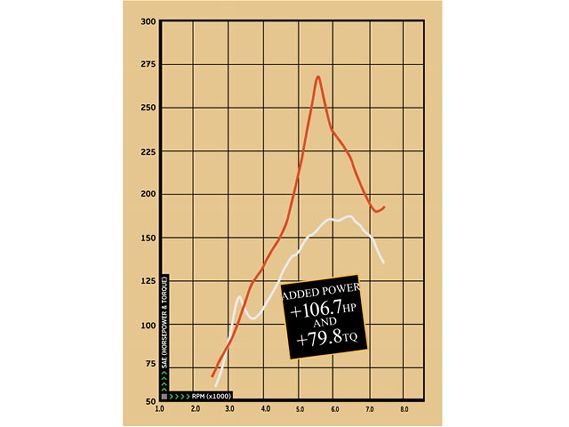 | Top 10 Power Pages
| Top 10 Power Pages
Car: '92 Mitsubishi Eclipse Gs-T
Engine: 4G63
PeakHP: 290.3
PeakTQ: 278.4
In much the same way as the Civic or Integra may have best represented import culture throughout the '90s, tuned EVOs and WRXs are slowly beginning to steal the spotlight in the modern day. But for all their rally-inspired, JDM charm and massive power-potential, many forget that there existed an equally powerful, equally potent turbo, AWD, four-cylinder platform years before their release: the Mitsubishi Eclipse and Eagle Talon. Though it could be argued that the DSM platform was only half Japanese, it's better half was all that mattered to us: Mitsubishi's factory-turbocharged 4G63. It was the first four-cylinder to break numerous horsepower and 1/4 mile records before EVOs could carry the torch. The first generation Eclipse/Talon was a hit from the get-go among its die-hard fans, for reasons newcomers to the import-loving world figured out when 2NR published power gains of over 106whp and 79 lb-ft of torque by adding three parts, totaling only $604, to a '92 Eclipse in Power Pages. It was a power-per-dollar record that still stands to this day, that, considering today's small retail price of clean DSMs, shows these cars offer a performance value that's hard to beat.
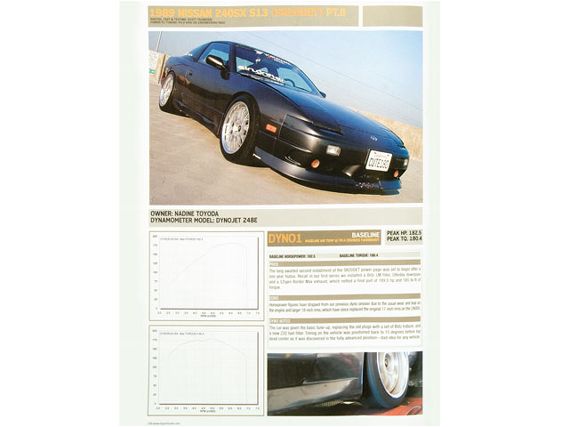 | Top 10 Power Pages
| Top 10 Power Pages
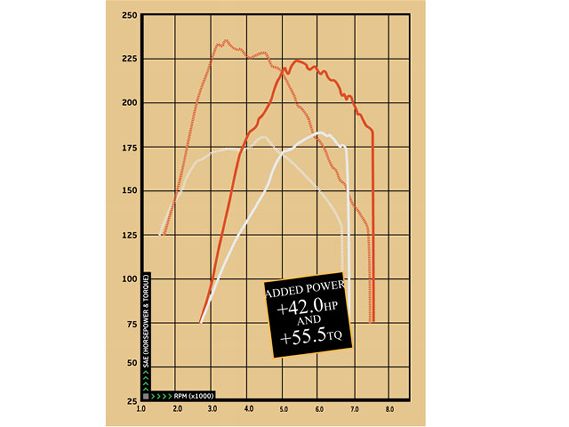 | Top 10 Power Pages
| Top 10 Power Pages
Car: '89 Nissan 240SX
Engine: S13 SR20DET (REDTOP)
PeakHP: 224.5
PeakTQ: 235.9
One of the most frustrating aspects of tuning imports in the States is that cars imported here are often never as good as similar cars created specifically for the JDM. I'm sure you can think of more than a few Type R-, Si-, or Evo-badged examples, but let's focus on everyone's favorite "girl that got away" for a moment: Silvia. While the USDM received a naturally aspirated truck engine in the body of a 240SX, Silvia's heart beat as pure as the rising sun itself, by way of an SR20DET. Even her rag-tag little brother, the 180SX, was given the same incredibly stout, turbocharged powerplant in their homeland, but no official Stateside version of the car was as fortunate. After tuners realized how easily the conversion could be performed on their 240SXs, and how incredibly stout the SR20DET is-nearly 600whp on a stock block has been seen so far-the rest was history. When 2NR published gains of over 40 whp and 55 lb-ft of torque found when upgrading one SR20DET's fuel, engine management, and boost control systems in preparation for future modification, the import world saw first hand benefits of upgrading this JDM powerplant correctly.
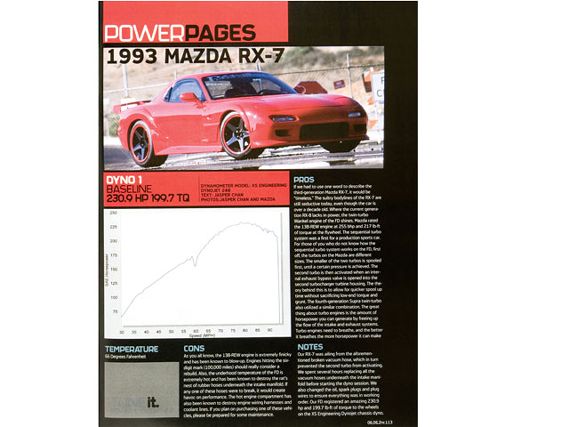 | Top 10 Power Pages
| Top 10 Power Pages
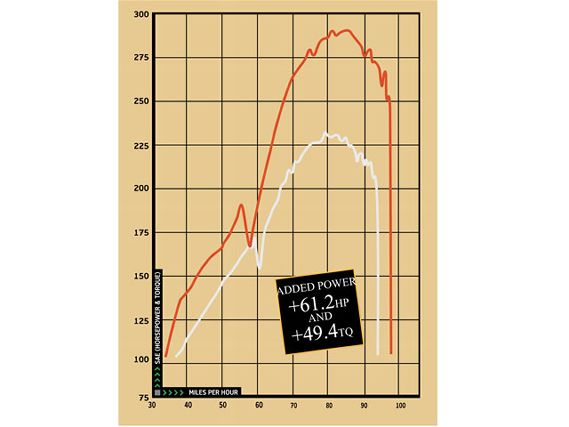 | Top 10 Power Pages
| Top 10 Power Pages
Car: '93 Mazda RX-7
Engine: 13B-REW
PeakHP: 292.1
PeakTQ: 249.1
If you're the type to root for the underdog, who likes a challenge or who prefers the road less traveled, chances are you've at least considered an RX-7 build. And if you've attempted one, you probably know how easy the 13B Wankel rotary engine is to destroy. Any attempt at modifications or elevating boost must be met with just the right introduction of additional fuel, all while warding off additional heat. Just one pre-ignition event is all it takes to require an engine replacement or rebuild - something that happened on the regular for years, enshrouding the 13B in mystery, before reliable aftermarket ECU systems became available. But when Eric Hsu and XS Engineering revisited the 13B via Power Pages and showed that a properly tuned A'PEXi Power FC could produce just under 50 whp-reliably-on a well-maintained FD RX-7, the 13B suddenly appeared a little less fearsome.
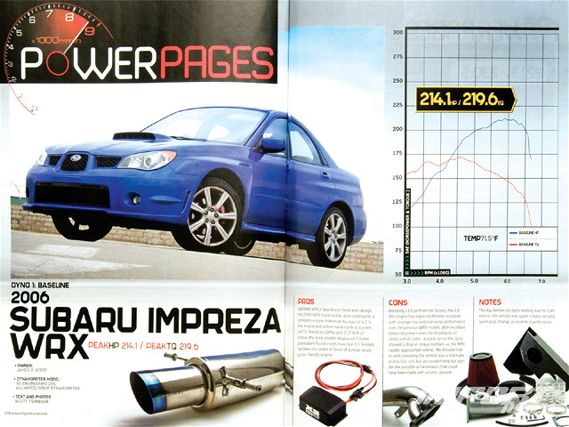 | Top 10 Power Pages
| Top 10 Power Pages
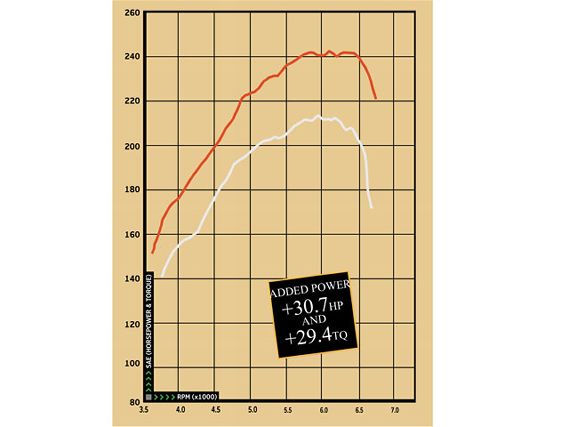 | Top 10 Power Pages
| Top 10 Power Pages
Car: '06 Subaru Impreza WRX
Engine: EJ255
PeakHP: 244.8
PeakTQ: 249.0
Did you watch the X Games rally event this year? If so, you witnessed one car manufacturer flat-out dominate the competition, claiming not only the top three finishing spots, but every finishing spot altogether. Not that this came as much of a surprise; Subaru has been as much a part of rally racing as dirt and gravel since their involvement in the discipline nearly 25 years ago. The company has claimed three driver and three manufacturer championship titles in the WRC, and over 47 manufacturer wins altogether, the vast majority of which, with Imprezas that were nearly identical to showroom stock models released in the US since 2002 - all powered by ever-evolving, horizontally opposed, four-cylinder "boxer" engines. And just in case today's WRX and STI models don't satisfy your power hunger in stock form, make sure to refer to the August '06 issue's Power Pages, where we found over 30 whp and nearly as many lb-ft of torque by applying simple bolt-ons to an EJ255 in one of the first modern-day STIs to roll off the line.
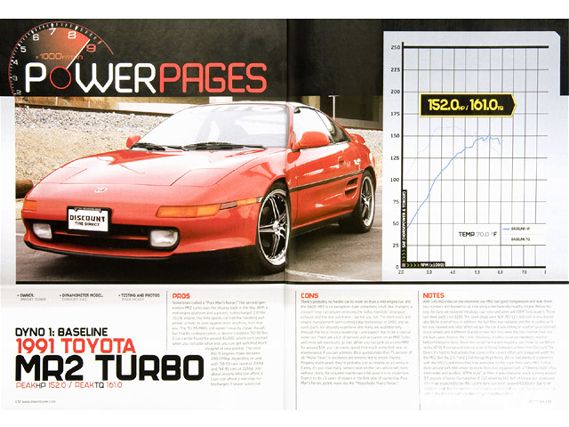 | Top 10 Power Pages
| Top 10 Power Pages
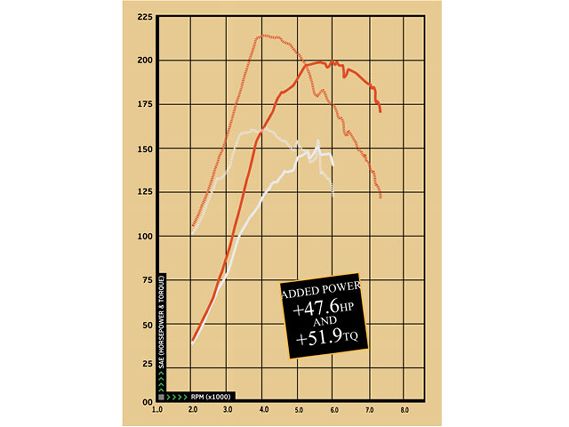 | Top 10 Power Pages
| Top 10 Power Pages
Car: '91 Toyota MR2 Turbo
Engine: 3S-GTE
PeakHP: 200.0
PeakTQ: 213.4
The early '90s Japanese performance car race was dominated so heavily by a select few big horsepower brawlers, that one of the best performing platforms of the day-the Toyota MR2-easily gets overlooked in hindsight. With the SW20 MR2's U.S. debut amidst full-scale production of the MK III Supra Turbo and Mazda's RX-7 Turbo II, and clouded by the release of the twin-turbo Z32 300ZX the same year-not to mention rumors of the upcoming Supra, RX-7, and Mitsu 3000GT VR4-the mid-engine, RWD MR2 had to struggle to keep its vents above water, despite its incorporation of one of Toyota's strongest four-cylinders ever produced; the turbocharged 3S-GTE. For our 100th issue just over a year ago, 2NR revisited this gone and almost forgotten mid-ship and was able to extract approximately 50 whp and 50 lb-ft of torque with the addition of an exhaust, boost controller, and tuned engine management system, further reinforcing why rounding up one of these little guys to build into a giant killer isn't such a bad idea.
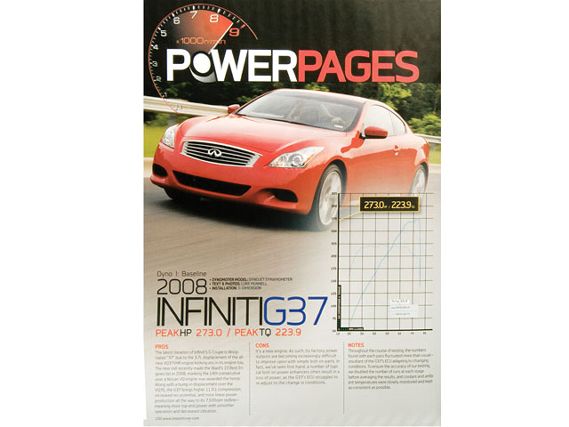 | Top 10 Power Pages
| Top 10 Power Pages
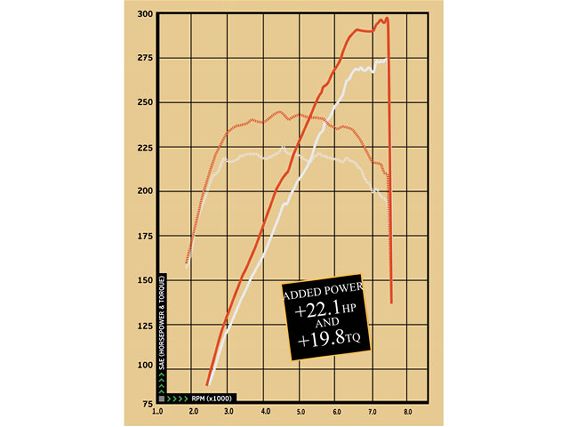 | Top 10 Power Pages
| Top 10 Power Pages
Car: '08 Infiniti G37
Engine: VQ37VHR
PeakHP: 295.1
PeakTQ: 242.8
It doesn't take a genius to understand why different makes of the same performance part might have different effects on power when applied to the same engine; some parts are simply engineered and built better than others. But every once in a while, there comes an engine that seems to make no additional power, no matter which company's product you throw at it. Nissan's VQ-series engine is one. Nissan's engine management system in the 350Z and G35/37 so strictly monitors and adapts to changes in airflow, that few bolt-on performance parts unleash real any power on the cars, despite the incredible potential of VQ engines. When we tested Nissan's newest variant of the VQ in an '08 G37 a few months back, we actually found that the car lost power by installing an aftermarket intake kit. Regardless, Stillen's high-flow cats and cat-back exhaust were good for nearly 20 whp and lb-ft of torque on the car, and A'PEXi's grounding kit added the proverbial cherry on top, with a couple more ponies. Future modifications to the car freed over 30 more ponies with the re-addition of an intake kit and ROM tuning - underscoring the role ECU tuning and properly engineered performance parts will play in improving performance of newer cars into the future.

